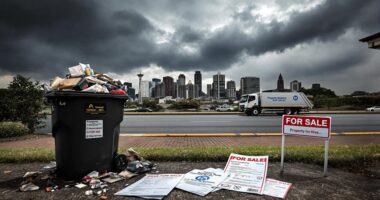South Africa is countering upcoming US tariff hikes with a multi-pronged economic approach. The government has increased VAT by 0.5%, frozen income tax brackets, and allocated R1.03 trillion for infrastructure development. Despite facing 31% US tariffs in 2025, officials are diversifying export markets toward Asia, Europe, and Africa. With projected GDP growth of 1.6% by 2025 and recent energy stability improvements, the nation’s strategy balances debt management with social protection. The full economic blueprint reveals more ambitious targets.
South Africa is making several bold economic moves to stabilize its financial future. The government has increased VAT by 0.5% annually for two years to fund education and healthcare. It’s also frozen personal income tax brackets, which will bring in R23 billion over three years. These measures aim to stabilize government debt at 76.2% of GDP by 2025/26, though debt-service costs still consume 22% of revenue.
To protect citizens from these tax impacts, social grants have increased considerably. The government has also directed R4 billion from strategic oil reserve sales to the National Revenue Fund. These steps form part of a broader strategy to manage finances while supporting vulnerable households.
Safety nets expand as taxation tightens, with social grants rising and R4 billion from oil reserves redirected to support vulnerable households.
Infrastructure investment stands at the center of South Africa’s economic plan. The government has allocated R1.03 trillion to public infrastructure over three years. Roads will receive R402 billion, energy projects R219.2 billion, and water infrastructure R156.3 billion. A new coordinating structure under the National Treasury will streamline public-private partnerships and project planning.
The country faces considerable external challenges, particularly a 31% US tariff hike starting April 2025. The concerning unemployment rate exceeds 30%, making these trade challenges particularly worrying for job creation efforts. This will hit key exports like automotive products, processed food, and chemicals. In response, South Africa is prioritizing the African Continental Free Trade Area to expand trade with neighboring countries. It’s also diversifying export markets to Asia, Europe, and the Middle East.
Despite these challenges, South Africa’s economic outlook shows promise. GDP growth is projected at 1.6% in 2025 and an average of 1.8% over three years. The country aims for 3% growth, though structural inefficiencies and low private investment remain obstacles. Recent improvements in energy security through reduced load shedding have helped business activity. Eskom’s commitment to ending load shedding has restored energy stability, encouraging businesses to resume normal operations and facilitating economic growth.
The impact of US tariffs may be less severe than feared. While the US accounts for 7.45% of South Africa’s exports, critical minerals like platinum, manganese, and gold will remain tariff-free. This maintains South Africa’s advantage in these sectors. Some exporters may reduce prices to offset tariffs, though this could hurt profits.
The government’s economic strategy balances multiple priorities: stabilizing debt, investing in infrastructure, protecting vulnerable citizens, and managing trade challenges. By directing 61% of infrastructure spending toward low-income households and introducing performance-based grants for municipal service providers, South Africa aims to create growth that benefits all citizens.
With interest rates recently cut to 11%, increased consumer spending could further boost economic activity despite the looming US tariffs.
Conclusion
South Africa’s economic strategy shows determination despite U.S. tariff challenges. The government’s plan aims to boost local industries and create jobs while guiding international trade tensions. Though facing significant hurdles, South African officials remain confident their approach will strengthen the economy over time. The coming months will reveal whether this bold move pays off for the nation’s financial future.







